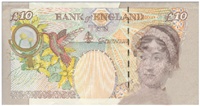UK banknotes to get tough new makeover from 2016
18 Dec 2013
UK banknotes are set to get a tough new makeover from 2016 when plastic will replace traditional paper, the Bank of England said today.
 The UK would be the largest economy so far to adopt, the more durable polymer material for general banknotes, after 87 per cent of respondents approved the change in a public consultation.
The UK would be the largest economy so far to adopt, the more durable polymer material for general banknotes, after 87 per cent of respondents approved the change in a public consultation.
The move would bring in estimated savings of £ 100 million, over a decade, beginning with £5 notes in 2015, and £10 notes to debut the year after.
Polymer notes were introduced by Australia in 1988 and are now in use across 20 countries including Canada, the homeland of new BoE governor Mark Carney.
The British notes would feature World War II leader Winston Churchill on the £five-pound note, while 19th-century author Jane Austen would figure on the higher denomination note (See: BoE confirms novelist Jane Austen to grace new £10 notes).
"Ensuring trust and confidence in money is at the heart of what central banks do. Polymer notes are the next step in the evolution of banknote design to meet that objective," Carney said in a statement.
The life of the notes is expected around six years, more than twice that of paper, allowing the bank 25 per cent savings.
The move comes after a three-year research found plastic notes stayed cleaner for longer, were more difficult to counterfeit and were at least 2.5 times longer-lasting.
A public consultation, that gave people the chance to handle the notes, found 87 per cent of 13,000 individuals who responded favoured polymer.
Carney said the quality of polymer notes was higher, they were more secure from counterfeiting, and they could be produced at a lower cost to the taxpayer and the environment.
The new notes would retain their familiar look, according to the bank, including the portrait of the Queen and a historical character.
A contract is expected to be signed with Innovia Security for the supply of polymer material. The company is expected to establish a polymer production plant in Wigton, Cumbria.
The bank acknowledged at the time of the launch of consultation in September, that plastic banknotes were more expensive to produce.
However, it argued, due to their durability they would prove cheaper in the long run.
According to the bank, due to their flexibility, plastic notes could fit into wallets as easily as paper banknotes.
The bank added the new notes would be slightly smaller than existing paper notes, but the practice of note size increasing with denomination would be maintained.






















